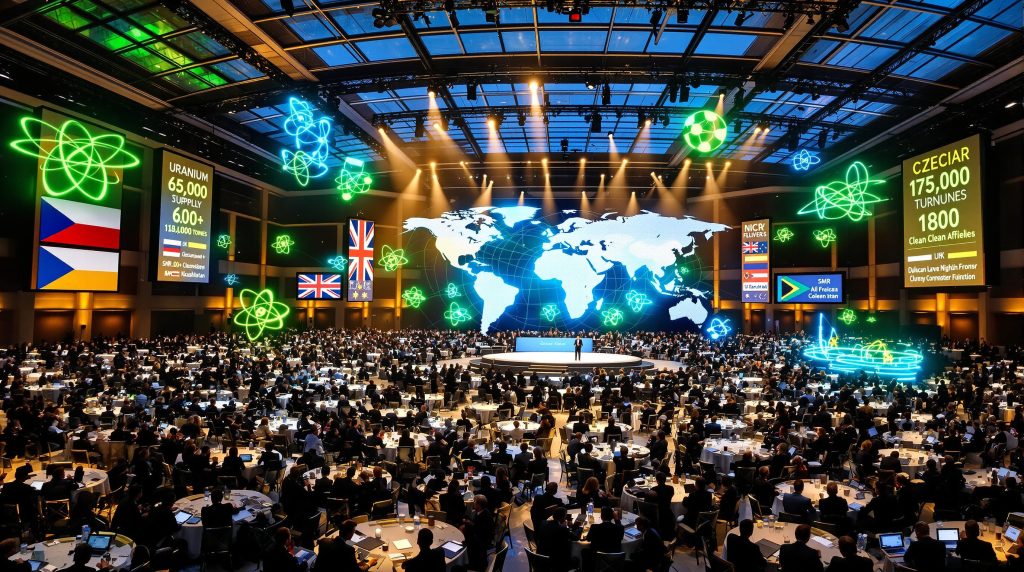The Evolution and Strategic Impact of the World Nuclear Symposium
The nuclear industry's most significant annual gathering serves as a cornerstone for global energy policy development and technological advancement. The World Nuclear Symposium has established itself as the primary forum where industry leaders, policymakers, and financial institutions converge to address critical challenges facing nuclear power deployment worldwide. With over 1,100 participants attending the 50th edition in London during September 2025, this milestone event demonstrated the growing momentum behind nuclear energy as a solution for climate change and energy security.
The symposium's strategic importance extends beyond traditional industry networking. As nations worldwide commit to net-zero emissions targets, nuclear energy represents a critical component of decarbonisation strategies. Furthermore, the event provides essential coordination between uranium producers, reactor manufacturers, financial institutions, and end-users seeking reliable, carbon-free electricity. This convergence creates opportunities for breakthrough collaborations that can accelerate nuclear deployment timelines and address supply chain constraints.
Historical Transformation from Technical Conference to Policy Platform
The World Nuclear Symposium has undergone remarkable evolution since its inception, transitioning from a primarily technical gathering to a comprehensive policy-shaping platform. The early decades focused heavily on reactor safety protocols and engineering advancements, reflecting the industry's initial priorities during the nuclear power expansion of the 1970s and 1980s.
The 2000s marked a significant shift toward international cooperation and regulatory harmonisation discussions. This evolution coincided with renewed interest in nuclear energy following concerns about climate change and energy security. The symposium began incorporating broader stakeholder perspectives, including financial institutions and government representatives seeking to understand nuclear energy's role in national energy strategies.
The current format, exemplified by the 2025 gathering, represents a mature approach to industry development. Specialised summit programmes now address specific stakeholder needs, creating targeted discussions that yield actionable outcomes. However, this structure acknowledges that nuclear expansion requires coordinated efforts across multiple disciplines beyond traditional engineering and operations.
Comprehensive Programme Structure and Specialised Summits
The symposium's architecture reflects the complex ecosystem required for successful nuclear deployment. The main executive programme features structured panel discussions addressing regulatory challenges, technological innovations, and market dynamics affecting global nuclear expansion. These sessions provide platforms for senior industry leaders to share insights on overcoming deployment barriers and accelerating project timelines.
Finance Summit: Addressing Capital Requirements
The dedicated Finance Summit addresses one of nuclear energy's most significant challenges: securing adequate capital for large-scale infrastructure projects. Financial institutions are demonstrating unprecedented interest in nuclear investments, driven by environmental, social, and governance considerations alongside long-term revenue stability.
Key financial instruments gaining traction include:
- Green bonds specifically structured for nuclear projects
- Blended finance mechanisms combining public and private capital
- Power purchase agreements with investment-grade counterparties
- Development finance institution participation in emerging markets
Victoria Kalb from UBS highlighted the growing institutional investor appetite for nuclear assets, emphasising the difficulty in overstating demand from major financial institutions. This interest stems from nuclear energy's unique characteristics: stable cash flows over extended operating periods, essential grid services provision, and alignment with climate investment mandates.
Energy Users Summit: Industrial Decarbonisation Focus
Large energy consumers are increasingly driving nuclear development through direct procurement strategies. The Energy Users Summit addresses this growing market segment, where corporations seek reliable, carbon-free electricity to meet sustainability commitments while maintaining operational requirements.
Primary end-user sectors include:
- Data centres requiring 24/7 reliable power supply
- Manufacturing facilities with high energy intensity
- Mining operations in remote locations
- Hydrogen production facilities supporting industrial decarbonisation
These end-users are developing sophisticated procurement strategies that include long-term contracts, direct investment participation, and partnership arrangements with nuclear developers. Consequently, such agreements reduce project risks and provide revenue certainty that facilitates financing.
Critical Findings from the 2025 World Nuclear Fuel Report
The release of the World Nuclear Fuel Report during the symposium provided sobering analysis of potential supply-demand imbalances facing the nuclear industry. The report identified significant gaps that could emerge across the fuel cycle if investment decisions are delayed beyond the current window of opportunity.
Uranium Supply Chain Vulnerabilities
Current global nuclear capacity of approximately 393 gigawatts requires substantial fuel cycle infrastructure to support operations. However, ambitious expansion targets aiming for 1,180 gigawatts by 2050 will require unprecedented supply chain investments across multiple stages of fuel production.
Critical supply chain metrics:
| Stage | Current Capacity | Projected Requirements | Investment Gap |
|---|---|---|---|
| Uranium Mining | 65,000 tonnes annually | 130,000+ tonnes by 2040 | 100% capacity increase |
| Conversion Services | Limited global capacity | 50% expansion required | Geographic diversification |
| Enrichment Services | Geopolitically concentrated | Strategic reserve creation | Supply security enhancement |
Meirzhan Yussupov from Kazatomprom, representing the world's largest uranium producer, emphasised the industry's commitment to meeting growing demand while highlighting the long lead times required for new production capacity. Kazakhstan currently supplies approximately 40% of global uranium, creating concentration risks that require strategic mitigation. In addition, recent uranium mining halt in Namibia has further highlighted supply chain vulnerabilities.
Investment Timeline Imperatives
Industry experts stressed that fuel cycle investments must commence immediately to avoid shortages during the anticipated nuclear expansion of the 2030s and 2040s. The typical development timeline for new uranium mines spans 7-15 years from discovery to production, while conversion and enrichment facilities require 5-10 years for construction and commissioning.
Malcolm Critchley from ConverDyn highlighted the critical nature of conversion capacity, noting that this stage represents a significant bottleneck in the fuel cycle. Conversion facilities transform mined uranium into the chemical form required for enrichment, but global capacity has been constrained by market consolidation and limited investment in recent decades. This contributes to ongoing uranium market volatility across supply and demand dynamics.
Advanced Nuclear Technologies and Deployment Strategies
The World Nuclear Symposium featured extensive discussions on advanced reactor technologies, particularly small modular reactors that promise enhanced deployment flexibility and reduced capital requirements. These innovations represent potential solutions to traditional nuclear power challenges, including high upfront costs and lengthy construction timelines.
Small Modular Reactor Development Progress
SMR technologies are advancing through regulatory approval processes in multiple jurisdictions, with several designs approaching commercial deployment. These systems offer advantages including factory manufacturing, modular construction approaches, and enhanced safety features through passive systems.
SMR deployment advantages:
- Reduced capital requirements per unit
- Shorter construction timelines
- Enhanced siting flexibility
- Scalable capacity additions
Michelle Catts from GE Vernova Hitachi Nuclear Energy discussed the progression of SMR technologies through regulatory review processes, emphasising the importance of international cooperation in establishing common safety standards and deployment frameworks. Furthermore, advances in US uranium production tech are supporting domestic fuel cycle capabilities.
Nuclear Transport and Logistics Infrastructure
Pete Bryant from the World Nuclear Transport Institute highlighted the sophisticated logistics requirements supporting nuclear fuel transportation and waste management. The industry maintains exceptional safety records through comprehensive training, specialised equipment, and international coordination protocols.
Transportation infrastructure must evolve to support increased nuclear deployment, requiring enhanced capacity for fresh fuel shipments, spent fuel management, and component transportation for new reactor construction. For instance, international shipping protocols continue advancing to address security concerns while facilitating trade in nuclear materials and equipment.
National Nuclear Programme Development Strategies
Government representatives shared insights on creating supportive policy environments for nuclear expansion. These discussions revealed diverse approaches to regulatory frameworks, financing mechanisms, and international cooperation agreements that facilitate nuclear development.
Country-Specific Programme Initiatives
Tomas Ehler from the Czech Republic's Ministry of Industry and Trade outlined his country's nuclear expansion strategy, which includes plans for new reactor construction and enhanced fuel cycle security. The Czech approach emphasises European cooperation while maintaining strategic autonomy in nuclear technology choices.
National programme elements include:
- Long-term energy planning integration
- Regulatory framework modernisation
- Workforce development programmes
- International partnership establishment
Loyiso Tyabashe from the South African Nuclear Energy Corporation discussed energy transition planning in emerging economies, where nuclear power can provide reliable baseload generation while supporting industrial development. South Africa's approach emphasises local capability development and technology transfer arrangements. Similarly, WA uranium mining status demonstrates varied regional approaches to nuclear fuel development.
International Cooperation Models
Michael Huebel from the Euratom Supply Agency emphasised the importance of international coordination in fuel supply security and regulatory harmonisation. European cooperation models demonstrate how regional partnerships can enhance nuclear deployment while maintaining competitive markets.
Bilateral agreements between nuclear-capable nations are facilitating technology transfer, joint development projects, and shared research initiatives. These partnerships accelerate deployment timelines while distributing development costs and risks across multiple participants.
Financial Innovation and Investment Strategies
The symposium revealed significant evolution in nuclear financing approaches, with institutional investors developing sophisticated strategies for nuclear asset participation. Traditional project finance models are being enhanced through innovative structures that address nuclear power's unique characteristics.
Institutional Investment Trends
Mark Muldowney from BNP Paribas discussed the bank's expanding involvement in nuclear financing, highlighting the asset class's alignment with long-term investment strategies and climate objectives. Major financial institutions are developing specialised teams and investment vehicles focused on nuclear opportunities.
Investment attraction factors:
- Stable cash flows over 60-80 year operating periods
- Essential grid services provision
- Inflation protection through long-term contracts
- Portfolio diversification benefits
Matt Firla-Cuchra from KPMG emphasised the growing sophistication of nuclear investment analysis, with financial institutions developing enhanced risk assessment frameworks that properly value nuclear assets' unique attributes. These developments align with broader uranium investment strategies emerging in the market.
Risk Management Framework Evolution
Modern nuclear financing incorporates advanced risk assessment models addressing construction timelines, regulatory approval processes, and technology deployment challenges. These frameworks acknowledge that nuclear projects require different evaluation criteria compared to conventional power generation investments.
Lauren Culver from the World Bank discussed multilateral development bank involvement in nuclear financing, particularly in emerging markets where nuclear power can support economic development while providing clean electricity access.
Grid Integration and Energy System Benefits
Nuclear power's role in supporting grid stability and renewable energy integration featured prominently in symposium discussions. As electricity systems incorporate increasing variable renewable generation, nuclear plants provide essential services that maintain system reliability.
Baseload Power and Grid Services
Lee McDonough from the UK Department for Energy Security and Net Zero discussed nuclear power's contribution to national energy security and net-zero commitments. Nuclear plants provide consistent electricity generation regardless of weather conditions, complementing variable renewable sources.
Grid stability services include:
- Frequency regulation and voltage support
- Black start capabilities for system recovery
- Inertia provision for system stability
- Long-term fuel supply security
Nuclear plants increasingly operate in flexible modes, adjusting output to support grid balance while maintaining high capacity factors. This flexibility enhances the value proposition for nuclear generation in modern electricity markets.
Complementary Renewable Integration
The symposium explored nuclear energy's synergistic relationship with renewable generation, where nuclear provides reliable baseload power that enables higher renewable penetration rates. This partnership approach optimises both technologies' contributions to decarbonisation objectives.
Combined nuclear and renewable portfolios offer superior reliability compared to either technology alone, while maintaining carbon-free electricity generation. Such hybrid approaches are gaining traction among utilities seeking to balance environmental objectives with system reliability requirements.
Workforce Development and Technical Capability
Industry leaders emphasised the critical importance of workforce development in supporting nuclear expansion plans. The sector requires specialised skills across multiple disciplines, from nuclear engineering to project management and regulatory affairs.
Skill Development Priorities
Current workforce challenges include replacing retiring experienced professionals while expanding capacity to support new project development. Educational institutions are developing enhanced nuclear engineering programmes, but industry-specific training remains essential for operational readiness.
Key capability areas include:
- Nuclear engineering and reactor physics
- Radiation protection and safety analysis
- Project management for complex construction
- Regulatory affairs and licensing expertise
International cooperation in workforce development is facilitating knowledge transfer and capability building, particularly in countries developing new nuclear programmes. Experienced nuclear nations provide training support and technical assistance to emerging nuclear markets.
Technology Transfer and Capability Building
Vendor companies are establishing regional training centres and partnership arrangements that develop local capabilities while supporting technology deployment. These initiatives create sustainable workforce development pathways that support long-term nuclear programme success.
Future Outlook and Strategic Priorities
The World Nuclear Symposium concluded with clear identification of critical near-term actions required to maintain nuclear energy's growth trajectory. Industry stakeholders expressed confidence in nuclear power's expanding role while acknowledging the substantial coordination required for successful implementation.
Immediate Action Requirements
Priority initiatives include:
- Supply chain investment commitments for uranium, conversion, and enrichment capacity expansion
- Regulatory harmonisation to streamline approval processes across international markets
- Financial innovation to address nuclear project characteristics and risk profiles
- Workforce development programmes to support expanding nuclear operations and construction
Sama Bilbao y León from the World Nuclear Association emphasised the industry's collective responsibility to address these challenges through coordinated action and continued international cooperation.
Long-term Strategic Development
The path forward requires sustained commitment across multiple stakeholder groups, from government policymakers to private investors and technology developers. Success depends on maintaining momentum while addressing legitimate concerns about nuclear deployment timelines and costs.
Strategic focus areas include:
- Advanced reactor technology commercialisation
- Fuel cycle optimisation and waste management solutions
- International cooperation framework enhancement
- Public acceptance improvement through transparent communication
"The World Nuclear Symposium demonstrates that nuclear energy has transitioned from a niche technology discussion to mainstream energy policy consideration. The convergence of climate objectives, energy security concerns, and technological advancement creates unprecedented opportunities for nuclear expansion, provided stakeholders maintain coordinated efforts across the complex implementation requirements."
The symposium's 50th edition marked not just a milestone celebration, but a strategic inflection point where nuclear energy's potential for addressing global challenges gained renewed recognition and commitment from diverse stakeholder groups worldwide.
Looking to Capitalise on Nuclear Energy Investment Opportunities?
Discovery Alert's proprietary Discovery IQ model delivers real-time alerts on significant uranium and mineral discoveries across the ASX, instantly empowering subscribers to identify actionable opportunities ahead of the broader market. Begin your 30-day free trial today and secure your market-leading advantage in the expanding nuclear energy sector.




